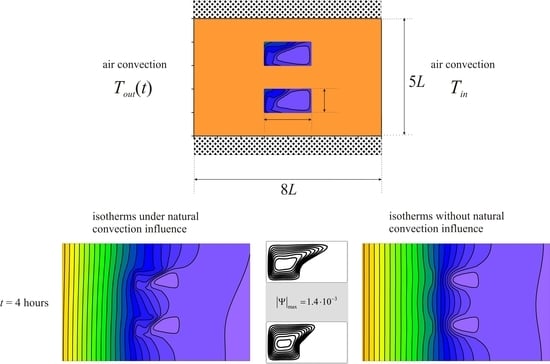Natural Convection Melting Influence on the Thermal Resistance of a Brick Partially Filled with Phase Change Material
Abstract
:1. Introduction
2. Materials and Methods
- At the boundaries between paraffin and brick:
- 2.
- On the right border:
- 3.
- On the left border:
- 4.
- At the upper and lower boundaries:
3. Results and Discussion
4. Conclusions
Author Contributions
Funding
Data Availability Statement
Conflicts of Interest
Nomenclature
| Bi | Biot number |
| C | specific heat, J K−1 kg−1 |
| g | gravitational acceleration, m s−2 |
| h | enthalpy, J kg−1 |
| k | thermal conductivity, W K−1m−1 |
| L | cavity height, m |
| LF | fusion energy or latent heat of melting, J kg−1 |
| p | pressure, Pa |
| P | dimensionless half-cycle equivalent to 12 hours in dimensional time |
| Pr | Prandtl number |
| Ra | Rayleigh number |
| Ste | Stefan number |
| t | time, s |
| T | temperature, °K |
| TF | melting temperature |
| u, v | velocity components in Cartesian coordinate along x and y, m s−1 |
| U, V | dimensionless velocity components |
| x, y | Cartesian coordinate, m |
| X, Y | dimensionless Cartesian coordinates |
| Greek symbols | |
| α | thermal diffusivity, m2 s−1 |
| β | coefficient of thermal expansion, K−1 |
| γ | heat transfer coefficient, W K−1 m−2 |
| Θ | dimensionless temperature |
| μ | dynamic viscosity, Pa s |
| ν | kinematic viscosity, m2 s−1 |
| ρ | density, kg·m−3 |
| τ | dimensionless time |
| ψ | stream function, m2 s−1 |
| Ψ | dimensionless stream function |
| ω | vorticity, s−1 |
| Ω | dimensionless vorticity |
| Subscripts | |
| b | brick |
| l | liquid |
| PCM | phase change material |
| s | solid |
References
- Barreneche, C.; Navarro, M.E.; Fernández, A.I.; Cabeza, L.F. Improvement of the thermal inertia of building materials incorporating PCM. Evaluation in the macroscale. Appl. Energy 2013, 109, 428–432. [Google Scholar] [CrossRef]
- Pasupathy, A.; Velraj, R. Effect of double layer phase change material in building roof for year round thermal management. Energy Build. 2008, 40, 193–203. [Google Scholar] [CrossRef]
- Mourid, A.; El Alami, M. Thermal behavior of a building provided with phase-change materials on the roof and exposed to solar radiation. J. Sol. Energy Eng. 2017, 139, 1–10. [Google Scholar] [CrossRef]
- Gounni, A.; El Alami, M. The optimal allocation of the PCM within a composite wall for surface temperature and heat flux reduction: An experimental approach. Appl. Therm. Eng. 2017, 127, 1488–1494. [Google Scholar] [CrossRef]
- Guarino, F.; Dermardiros, V.; Chen, Y.; Rao, J.; Cellura, M.; Mistretta, M. PCM thermal energy storage in buildings: Experimental study and applications. Energy Procedia 2015, 70, 219–228. [Google Scholar] [CrossRef] [Green Version]
- Souayfane, F.; Henry, P.; Fardoun, F.; Achard, P. Energy performance and economic analysis of a TIM-PCM wall under different climates. Energy 2019, 169, 1274–1291. [Google Scholar] [CrossRef]
- Lagou, A.; Kylili, A.; Šadauskiene, J.; Fokaides, P.A. Numerical investigation of phase change materials (PCM) optimal melting properties and position in building elements under diverse conditions. Constr. Build. Mater. 2019, 225, 452–464. [Google Scholar] [CrossRef]
- Evers, A.C.; Medina, M.A.; Fang, Y. Evaluation of the thermal performance of frame walls enhanced with paraffin and hydrated salt phase change materials using a dynamic wall simulator. Build. Environ. 2010, 45, 1762–1768. [Google Scholar] [CrossRef]
- Souci, Y.O.; Houat, S. Numerical study of building materials filled by PCM for thermal energy storage. Silic. Based Compos. Mater. 2018, 70, 123–127. [Google Scholar] [CrossRef]
- Kosny, J.; Miller, W.A.; Yarbrough, D.; Kossecka, E.; Biswas, K. Application of Phase Change Materials and Conventional Thermal Mass for Control of Roof-Generated Cooling Loads. Appl. Sci. 2020, 10, 6875. [Google Scholar] [CrossRef]
- Li, D.; Zheng, Y.; Liu, C.; Wu, G. Numerical analysis on thermal performance of roof contained PCM of a single residential building. Energy Convers. Manag. 2015, 100, 147–156. [Google Scholar] [CrossRef]
- Lee, K.O.; Medina, M.A.; Raith, E.; Sun, X. Assessing the integration of a thin phase change material (PCM) layer in a residential building wall for heat transfer reduction and management. Appl. Energy 2015, 137, 699–706. [Google Scholar] [CrossRef]
- Memarian, S.; Kari, B.M.; Fayaz, R.; Asadi, S. Single and combined phase change materials: Their effect on seasonal transition period. Energy Build. 2018, 169, 453–472. [Google Scholar] [CrossRef]
- Berardi, U.; Soudian, S. Experimental investigation of latent heat thermal energy storage using PCMs with different melting temperatures for building retrofit. Energy Build. 2019, 185, 180–195. [Google Scholar] [CrossRef]
- Sinka, M.; Bajare, D.; Jakovics, A.; Ratnieks, J.; Gendelis, S.; Tihana, J. Experimental testing of phase change materials in a warm-summer humid continental climate. Energy Build. 2019, 195, 205–215. [Google Scholar] [CrossRef]
- Saafi, K.; Daouas, N. Energy and cost efficiency of phase change materials integrated in building envelopes under Tunisia Mediterranean climate. Energy 2019, 187, 115987. [Google Scholar] [CrossRef]
- Kant, K.; Shukla, A.; Sharma, A. Heat transfer studies of building brick containing phase change materials. Sol. Energy 2017, 155, 1233–1242. [Google Scholar] [CrossRef]
- Saxena, R.; Rakshit, D.; Kaushik, S.C. Experimental assessment of Phase Change Material (PCM) embedded bricks for passive conditioning in buildings. Renew. Energy 2019, 149, 587–599. [Google Scholar] [CrossRef]
- Saxena, R.; Rakshit, D.; Kaushik, S.C. Phase change material (PCM) incorporated bricks for energy conservation in composite climate: A sustainable building solution. Sol. Energy 2019, 183, 276–284. [Google Scholar] [CrossRef]
- Bhamare, D.K.; Rathod, M.K.; Banerjee, J. Numerical model for evaluating thermal performance of residential building roof integrated with inclined phase change material (PCM) layer. Build. Eng. 2020, 28, 101018. [Google Scholar] [CrossRef]
- Talebizadehsardari, P.; Mahdi, J.M.; Mohammed, H.I.; Moghimi, M.A.; Eisapour, A.H.; Ghalambaz, M. Consecutive charging and discharging of a PCM-based plate heat exchanger with zigzag configuration. Appl. Therm. Eng. 2021, 193, 116970. [Google Scholar] [CrossRef]
- Zadeh, S.M.H.; Mehryan, S.A.M.; Ghalambaz, M.; Ghodrat, M.; Young, J.; Chamkha, A. Hybrid thermal performance enhancement of a circular latent heat storage system by utilizing partially filled copper foam and Cu/GO nano-additives. Energy 2020, 213, 118761. [Google Scholar] [CrossRef]
- Saleh, H.; Siri, Z.; Ghalambaz, M. Natural convection from a bottom heated of an asymmetrical U-shaped enclosure with nano-encapsulated phase change material. J. Energy Storage 2021, 38, 102538. [Google Scholar] [CrossRef]
- Bondareva, N.S.; Sheremet, M.A. Effect of nano-sized heat transfer enhancers on PCM-based heat sink performance at various heat loads. Nanomaterials 2019, 10, 17. [Google Scholar] [CrossRef] [Green Version]
- Gau, C.; Viskanta, R. Melting and solidification of a pure metal on a vertical wall. J. Heat Transf. 1986, 108, 174–181. [Google Scholar] [CrossRef]
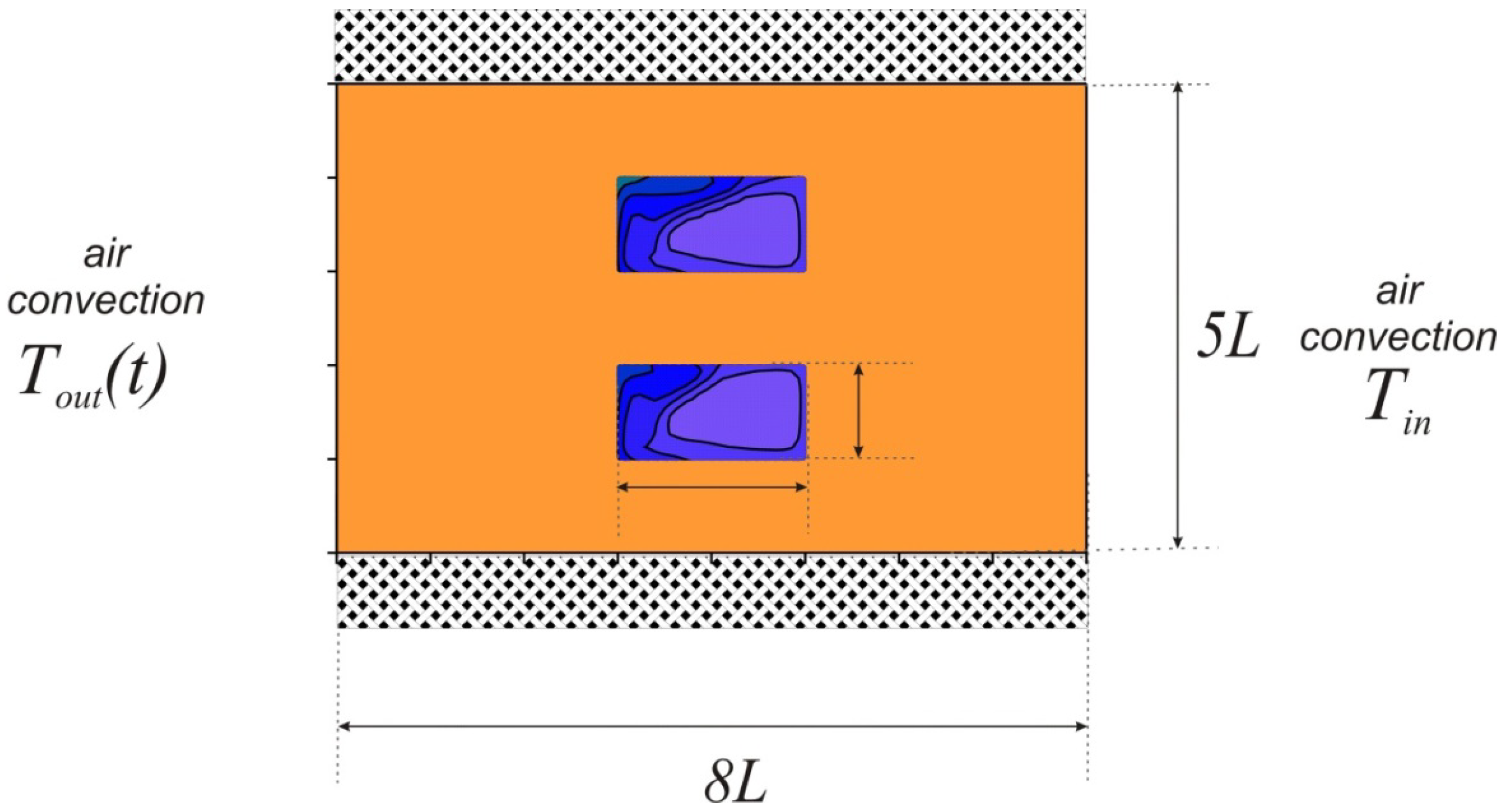
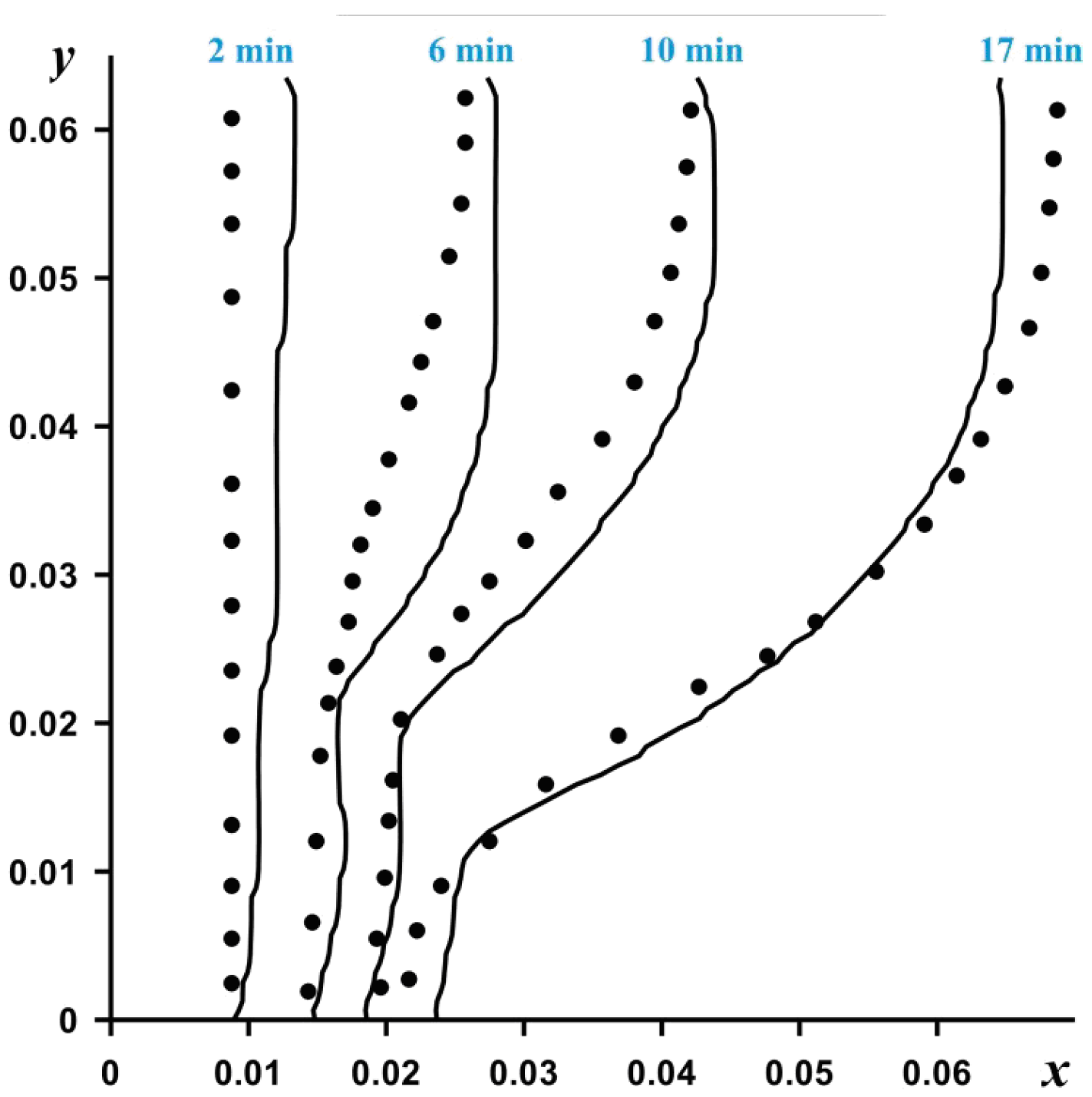


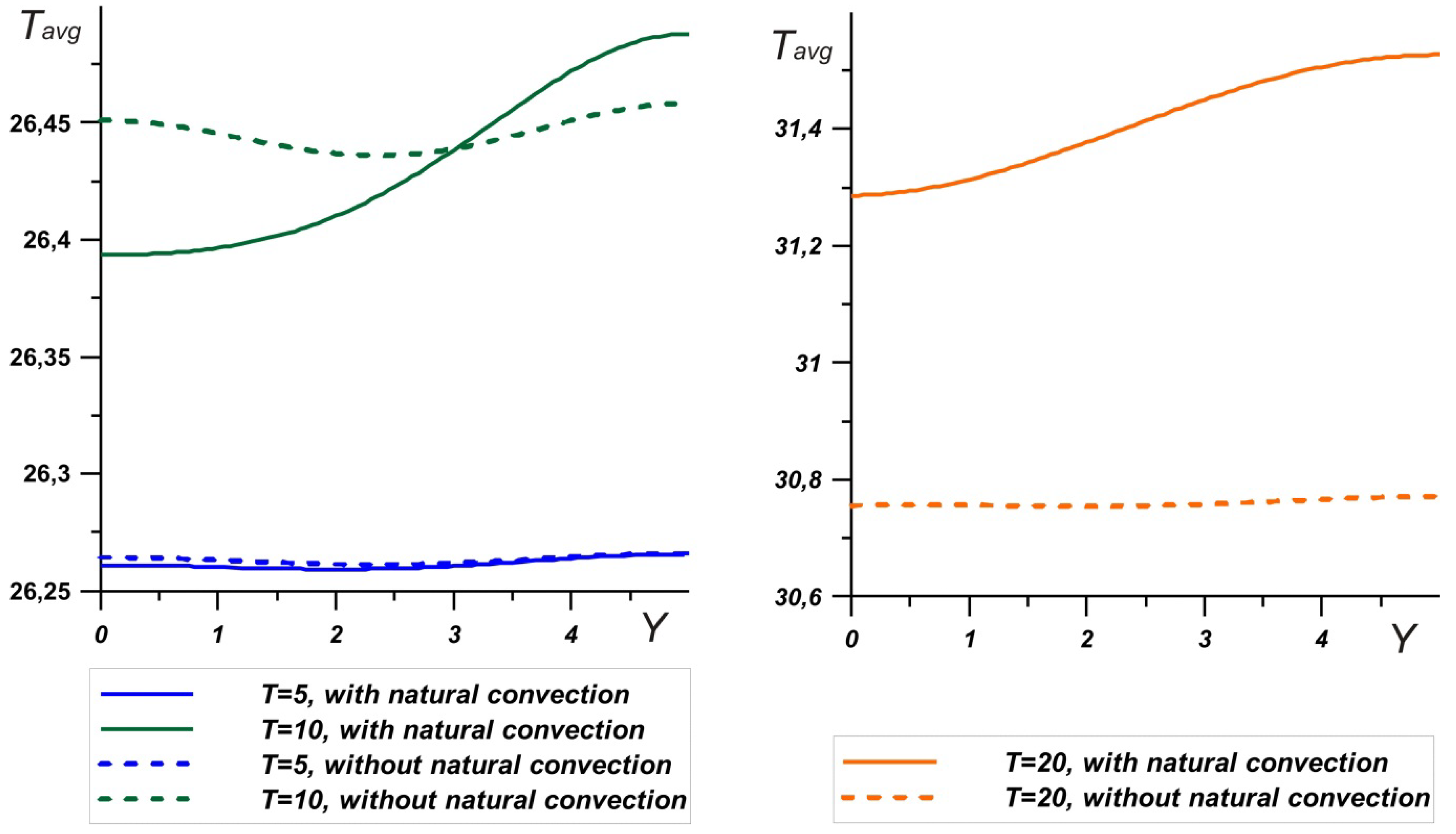

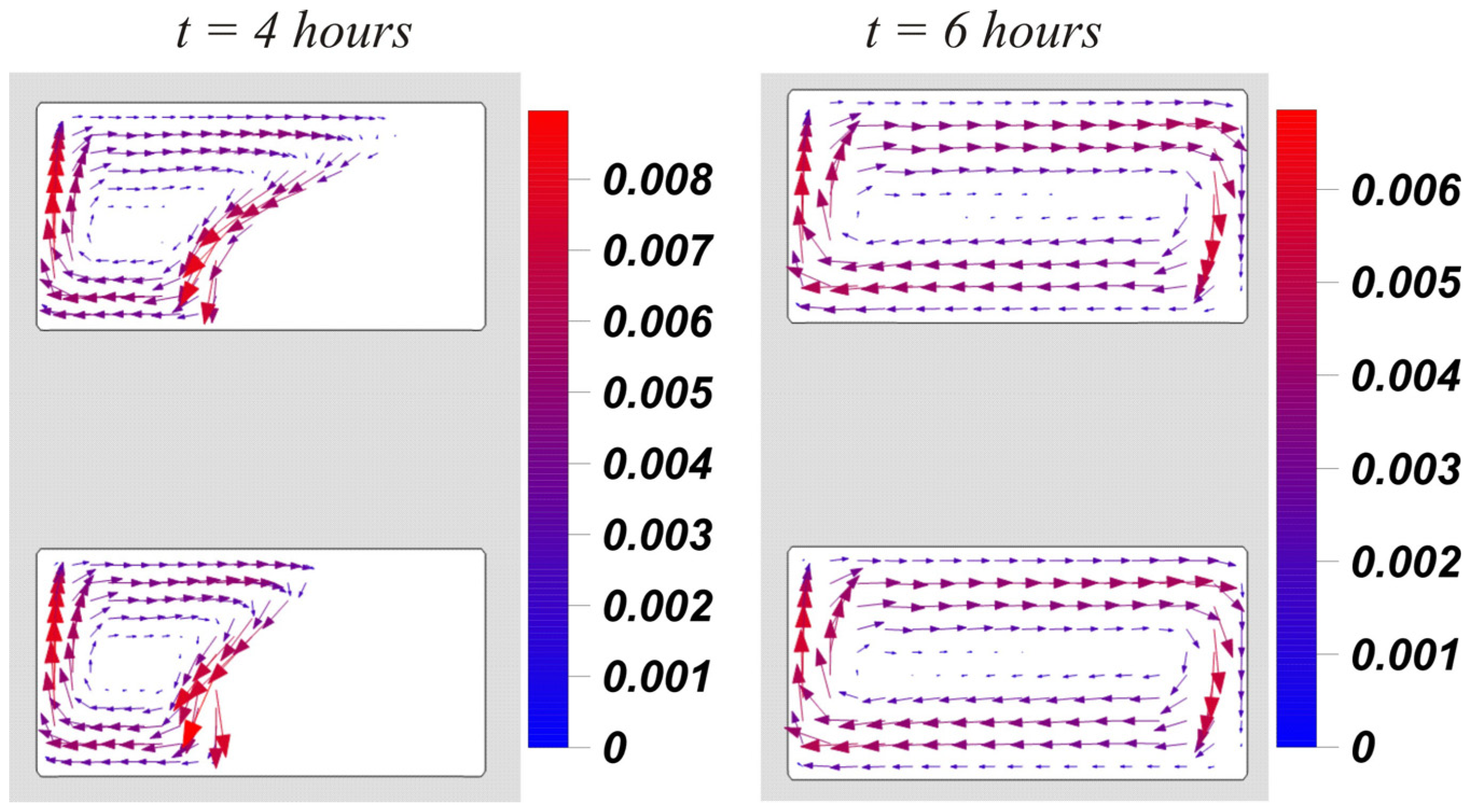

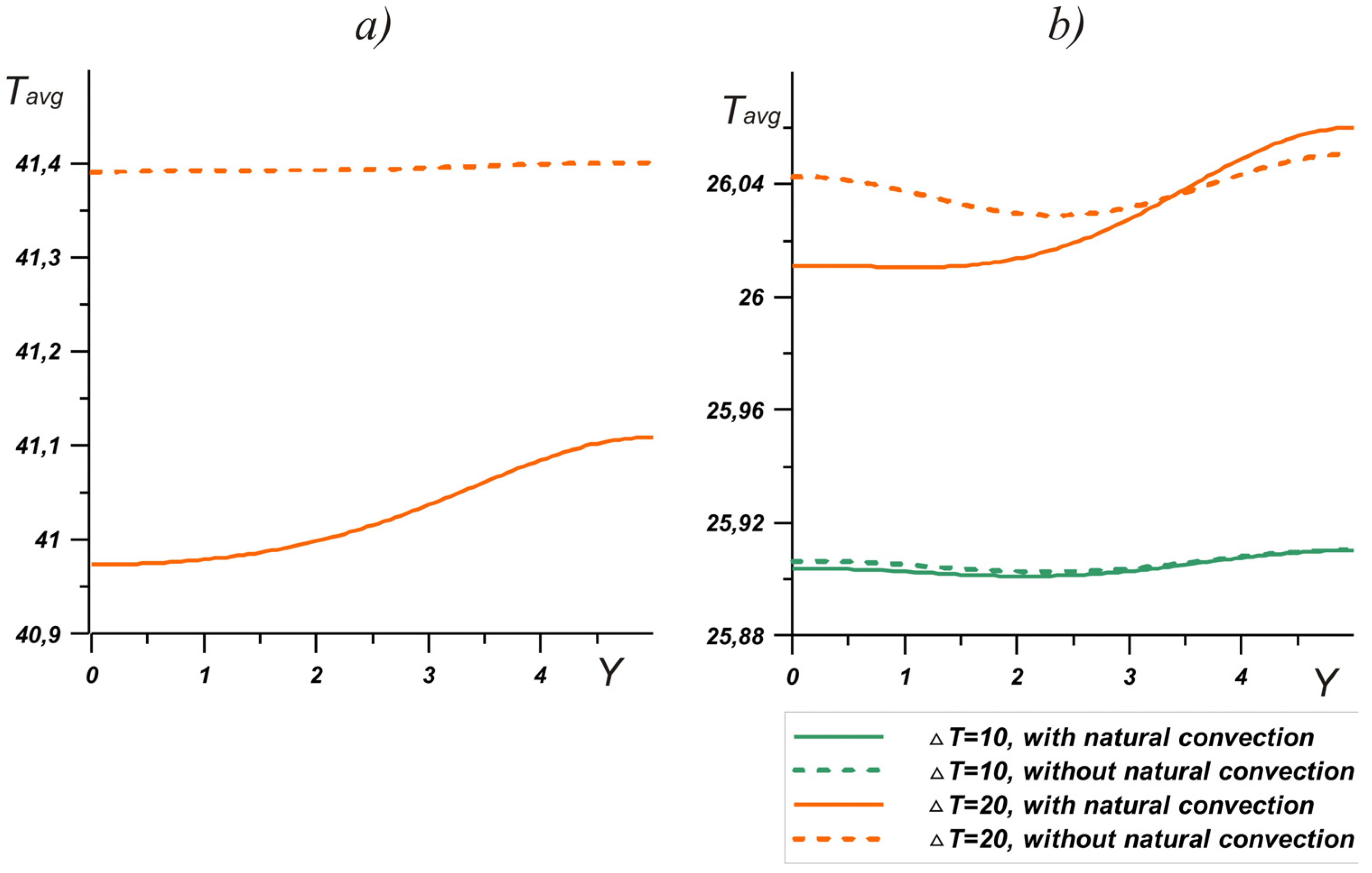
| Properties | k, W/(m∙K) | c, J/(kg∙K) | ρ, kg/m3 | μ, Pa∙s | Lf, J/kg | |||
|---|---|---|---|---|---|---|---|---|
| Solid | Liquid | Solid | Liquid | Solid | Liquid | |||
| Brick | 0.7 | 840 | 1600 | |||||
| RT25HC (Tf = 26.6 °C) | 0.19 | 0.18 | 1800 | 2400 | 785 | 749 | 0.00375 | 232,000 |
Publisher’s Note: MDPI stays neutral with regard to jurisdictional claims in published maps and institutional affiliations. |
© 2021 by the authors. Licensee MDPI, Basel, Switzerland. This article is an open access article distributed under the terms and conditions of the Creative Commons Attribution (CC BY) license (https://creativecommons.org/licenses/by/4.0/).
Share and Cite
Bondareva, N.S.; Sheremet, M.A. Natural Convection Melting Influence on the Thermal Resistance of a Brick Partially Filled with Phase Change Material. Fluids 2021, 6, 258. https://doi.org/10.3390/fluids6070258
Bondareva NS, Sheremet MA. Natural Convection Melting Influence on the Thermal Resistance of a Brick Partially Filled with Phase Change Material. Fluids. 2021; 6(7):258. https://doi.org/10.3390/fluids6070258
Chicago/Turabian StyleBondareva, Nadezhda S., and Mikhail A. Sheremet. 2021. "Natural Convection Melting Influence on the Thermal Resistance of a Brick Partially Filled with Phase Change Material" Fluids 6, no. 7: 258. https://doi.org/10.3390/fluids6070258
APA StyleBondareva, N. S., & Sheremet, M. A. (2021). Natural Convection Melting Influence on the Thermal Resistance of a Brick Partially Filled with Phase Change Material. Fluids, 6(7), 258. https://doi.org/10.3390/fluids6070258






